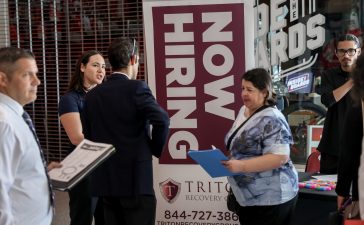It was Saturday night and the Dodo was dead. “I can’t really explain how soul-destroying it is when you have one gentleman in at 7.30pm on a Saturday,” said publican Lucy Do.
Until the pandemic, the name of this smart west London pub had managed not to be a hostage to fortune. Do’s pub is an award-winning modern community boozer in Hanwell, a stripped-back free house that takes the concept of a friendly atmosphere seriously enough that Do sometimes takes the time to introduce patrons to each other.
“It was the most depressing, quietest Saturday night of my entire six years in the business,” she said. “But then, at the beginning of this year, I had the most ridiculous, incredibly busy Sunday. But when you get a night like that Saturday, you think this is probably the end of my business now, because you forget that the weeks balance out – because it’s never been like that before.
“That’s what I’m battling with, and what I think other pub owners are battling with – you just cannot predict in the current climate. The only thing I could predict was that it was costing too much money to open on Tuesdays.”
Like a great many other publicans and restaurant owners, Do has reduced her pub’s opening hours. For her, that means shutting on Tuesdays. For others, it means calling last orders early, when all but a handful of customers have drifted away. Or it means opening later, and mothballing the cappuccino machine in the hope that perhaps things might change.
Exactly how many pubs and restaurants are cutting hours is not entirely clear, but it seems to be a substantial number. A survey of 500 hospitality businesses last month by Brita Professional found that 61% had reduced opening hours. A recent business confidence survey of 114 operators found 41% were reducing hours or days either because of costs or staffing problems.
UK Hospitality, the industry body, has been tracking how many of its members are reducing hours in its quarterly business confidence survey over the last year. The answer is about 25%, according to Kate Nicholls, its chief executive.
“It’s down from a high of a third at the beginning of the year,” Nicholls said. “So there’s a sense of settling towards a new normal, but we’re nowhere near there yet, and there’s a high degree of uncertainty.”
The reasons are easy to guess and hard to solve. The cost of doing business, and particularly the cost of energy, is a big factor, as are food inflation, VAT and rent increases.
Staffing costs are another. Brexit and the pandemic amputated 600,000 waiters, chefs, bar staff and others from the hospitality workforce in London alone and rising wages have not helped.
And then there is the phenomenon that Do experienced a few weekends ago: less-predictable customers leading less-predictable lives.

“We’re back to seeing 90% of the population out eating and drinking at least once a month,” Nicholls said. “Just under half of them are coming out weekly. So there is steady demand. But the main change is in city centres.”
Hybrid workers are more likely to be in the office on a Wednesday and a Thursday, and those have become the busiest days in city centres. But there are variations: suburban areas tended to be more reliably busy across the week, Nicholls said, while late-night venues and those aiming to draw a younger crowd have found things hardest, particularly with a fifth of under-25s choosing not to drink alcohol at all.
It’s a long way from the 1960s pub that could time its opening to the minute that a factory shift ended, or the pubs around Smithfield market in London that could open at 6am to cater for the meat traders finishing for the day.
“Uncertainty is the new norm as far as our members are concerned,” Nicholls said. “We haven’t really been able to catch a breath since Covid. You can’t assess patterns of behaviour because we’ve had Covid, the cost of living, the cost of doing business, the war in Ukraine and all of that economic uncertainty.”
A spectre looms in the chancellor’s autumn statement. If Jeremy Hunt removes rate relief for hospitality, that would threaten the future of thousands of businesses.
Even those that seem to be thriving are hiding personal costs. Kirstin Reynolds and her husband run the Ilchester Arms in Symondsbury, a popular gastropub in a pretty west Dorset village that has a regular stream of visitors, often for weddings.
The Ilchester was in the top 8% of pubs tied to the local brewer in terms of growth and performance, she said, but the couple were working 80-hour weeks even though they shut from 5pm on Sunday until Wednesday afternoons. Opening longer would mean more hours and they would lose money.
“We’re burnt out,” she said. “When we took on the pub [in April 2021] we thought the business would grow and we could fully staff and it and run seven days a week.”
They are nominally open until 10pm but often start putting chairs on tables at 9pm, an hour after the kitchen shuts. Occasionally wedding guests arrive on a Friday night, intending to have a grand evening the night before the big day. “They expect to see a bar full of locals. ‘Where are they?’ Yeah – they’re staying in all their houses.”
The few villagers that have not been priced out by holiday homes do value the pub, but most turn up at 5pm or 6pm and go home for dinner. “They’re very supportive but I’m not sure anyone has a full enough understanding of what it takes to run a pub at the moment.”
For one thing, it takes an ability to pay eye-watering energy bills, which, unlike domestic supplies, are not capped. Reynolds was lucky enough to get a deal before the crisis hit, but still had a 45% price increase this year. They turn off all the fridges at night and tried to install solar panels on the roof of a south-facing barn that would have covered a third of their energy costs. But a promised grant to cover some of the £18,000 cost never materialised because the scheme relied on EU’s European regional development fund, and that was not replaced by the government after Brexit, she said.
At least they serve food. Pubs that only serve drinks are struggling harder: “We charge £6.50 for a pint and we don’t make anywhere near our margin. They’d probably have to charge £9.50.”
Other licensees have grim tales of price rises. Boxes of cod jumped from £50 to £90 overnight, according to Jo Loring of the Cosy Dove in Newcastle. A lamb shank meal that would have cost £15.30 in 2019 would now need to be £28.80 to make the same profit margin. Cooking oil is up. Alcohol duty cuts to beer had not been passed on, while wine and spirit costs had risen, she said. If business rates go up, “for many pubs this will be the last straw”.
It has been particularly grim for music venues, with 127 closing or stopping live music since last summer – 16% of places in the UK. Most rely on beer, ticket sales and crowds of younger people.
“We need a model to make sure our cultural infrastructure can survive,” said Mark Davyd, the chief executive of the Music Venue Trust (MVT). “There is money, but it’s not going to the venues and it’s not going to the artists. The two big winners are landlords [who own the venues] and breweries.”
The MVT is trying something different – it has raised £2.3m so far through a crowdfunded scheme to buy at least nine venues for a community ownership scheme and bought the first – the Snug in Atherton, Manchester, last week. But he believes the music industry could do much more.
“Every Premier League club does something for sport in their community. They need the talent. Music is a £5bn industry – if you put 50p on every ticket that Coldplay sold at the Etihad and put that into a fund, none of the venues in Manchester would be closing. We’re reliant on grassroots music venues to bring us the artists of the future.”
J Mark Dodds, a former publican, has founded the People’s Pub Partnership in an attempt to do something similar for pubs. “The idea is to take closed pubs and reinvigorate them and engage the community,” he said. The costs borne by licensees had been exacerbated by the large pub companies, he said. “The pub companies have destroyed the pub sector, they’ve destroyed an essential part of British culture. There needs to be another way.”
The idea of the English pub goes back as far as the English language. Geoffrey Chaucer’s The Canterbury Tales not only start in a pub, the Tabard in Southwark, but the overbearing landlord is a substantial character and even gets a namecheck: Harry Bailly. He may even have been real.
Soap writers invented the Queen Vic, the Rover’s Return and the Bull in Ambridge. Writer Jeffrey Barnard’s residence at the Coach and Horses in Soho inspired a West End play and Ken Loach’s new film, The Old Oak, is about a publican struggling to keep the pub in his former mining village going.
Neil Gaiman’s Sandman makes a man immortal and has to meet him once at the same time every 100 years – where else could that happen except in a pub? When George Orwell created Nineteen Eighty-Four’s dystopia, he sent Winston Smith to a pub in an effort to find subversiveness: the twist was that they served litres, not pints. The idea that people might not actually go to pubs was inconceivable.
Or, rather, that men might not go to pubs. While Victorian landowners and politicians debated the proper amount of leisure time, weekends and holidays for working men, and donated land to make parks, women’s opportunities for leisure were not in the new sports clubs or the 100,000 pubs or so that existed at the beginning of the 20th century. Women were prominent in Britain’s temperance movements, aiming to end violence in the home.
They had some success, particularly with licencing laws, but the rise of the car and indoor attractions such as television gave people new options.
“They shifted away from collective forms of leisure,” said Alan Tomlinson, emeritus professor of leisure studies at the University of Brighton. “There was a kind of individualisation of what you could do with your time.”
Margaret Thatcher’s economic reforms in the 1980s, the emergence of countercultural movements and the invention of smartphones and 21st century media has accelerated that trend. As pubs have declined – there are now fewer than 50,000 – restaurants have boomed, particularly since the global financial crisis, with a growth in casual dining at burger and pizza chains. Sitting separately from other people is perhaps more appealing than the hurly-burly of trying to get served at a bar.
“People are after some wildness – they want something real because everything else seems to be crumbling around them,” said Tony Blackshaw, professor of leisure studies and sociology at Sheffield Hallam University. “People will always find something, whether that’s urban explorers looking for expression in the waste of modernity, or people going dogging.”
Still, pubs have experienced existential threats in the past and survived. The Tabard lasted 500 years after Chaucer, then the arrival of the railways took away passing trade for it and many other places, yet its neighbour, the George – popular with William Shakespeare and Charles Dickens – is still standing (rebuilt after a 17th century fire).
The idea of a public place where people could have a conversation without a purpose – one that wasn’t recorded on social media for future embarrassment – remains important, according to Blackshaw.
“The pub will continue to be important because it is a ‘real’ place we can still let ourselves go, find escape, sociability, see friendly faces, meet a partner, meet real characters, feel cultural continuity, share the experience of watching sport together – and, if we’re lucky, share a nice pint.”

The view from Paris: crisis, what crisis?
It is approaching midnight on a weekday and the terraces of the bars and brasseries in the Rue du Faubourg Saint-Denis are packed. The drinkers and diners are mostly young and largely Parisien; the district south of the Gare de l’Est and Gare du Nord terminuses is increasingly trendy but still edgy and off the traditional tourist beat.
The evening news programmes lament soaring food prices, outrageous petrol costs and rocketing fuel bills, but the young bar crowd colonising the pavement near Place de la République is in high spirits. They may have jobs or lectures to attend in the morning but are good humoured and belting out English and French pop songs as 1am looms. There is a lot of animated chatting but surprisingly few are falling over drunk.
A study published in February this year that looked at spending on 20 million credit cards found that despite a rise in the cost of living and a drop in purchasing power in 2022, the French continued to go out to eat and drink. The researchers found spending in bars increased 24% between 2021 and 2022 and in restaurants by 44% over the same period.
Another report suggested new bars and restaurants were springing up in many towns and cities around France, driving out smaller high street businesses and raising concerns about commercial diversity.
Recruiting staff has long been a problem in the French hospitality industry – there were an estimated 200,000 unfilled posts in the sector last year – but owners have responded by making jobs more attractive with higher pay and more flexible shift patterns.
A report by the consultants KPMG found 48% of French restaurant owners had raised wages to try to attract and keep staff, while 54% had adapted working hours. Almost a third were trying to attract recruits from outside the industry and more retraining schemes were being offered to older recruits looking to change careers.
Bernard Boutboul, president of the Gira consultancy specialising in the development and marketing of restaurants, described the sector as “one of the most resilient”, adding that 2022 had turned out to be “a euphoric recovery or a catch-up” for restaurant owners after the Covid lockdown closures of 2020 and 2021.
Kim Willsher

The view from New York: early nights in the city that never sleeps
Is New York, the city that never sleeps, now an early dining metropolis? Back in 1984, Jay McInerney wrote in Bright Lights, Big City that 11.40pm had been “a little too early for Odeon” one of the fashionable spots. Nowadays, Odeon closes at 11pm. Even Lucien, a Lower East Side place-to-be-seen, closes at 1am – at least officially.
But that’s still hours after the 6.30-8.30 reservations rush that restaurants say they are getting, with customers staying longer, cutting the opportunity to to re-use tables. Bars close earlier, too, and there are fewer places to dance.
What happened is a matter of conjecture. Was it the pandemic? Hook-up culture moving online? Food-delivery services? TV streaming? The costs of staffing and security? The city’s meat, fish and produce markets – from where the workers would be in the diners early giving the impression of a city that never sleeps – have been lost to residential gentrification.
Perhaps it’s the fitness and athleisure revolution – you are more likely to see early-morning joggers on the streets at 5am than late-night stragglers. “9pm Is the New Midnight,” New York magazine recently declared.
The one person who seems to be keeping the nightlife scene going is the city’s mayor, Eric Adams. He’s frequently out late, at the member’s club Zero Bond or at a midtown eaterie, Osteria La Baia. Last year, Adams called the city “so boring” during a pitch for tourists to return. “We’ve become a city of ‘nos’. I want it to become a city of excitement,” he added. But will he get it?
On the streets of Greenwich Village in Manhattan few people are around after the bars close. That may just mean that the late-night party scene has moved elsewhere – to Ridgewood in Queens where the artists are, or to the Bronx and the far stretches of Brooklyn. And that’s probably a matter of economics. New York is expensive, with rents at record levels. Except for banking and tech bros, it’s too pricey to let the tab run late into the night. For everyone else, New York has become a two-job town. And that means early starts.
“I do wonder if, these days, people are thinking about the check while they’re sitting at the bar,” says downtown publicist Kaitlin Phillips. “Then again, the bars used to close at 4am, now it’s 2am. So we’ve lost two hours, logistically speaking.” But, she adds for comparison, “London seems to have lost four.”
Edward Helmore











